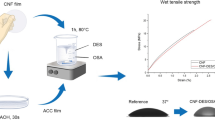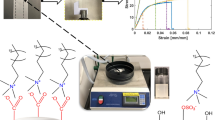Abstract
Bacterial cellulose (BC) nanofibres were modified only on their surface using an esterification reaction with acetic acid, hexanoic acid or dodecanoic acid. This reaction rendered the extremely hydrophilic surfaces of BC nanofibres hydrophobic. The hydrophobicity of BC increased with increasing carbon chain length of the organic acids used for the esterification reaction. Streaming (zeta-) potential measurements showed a slight shift in the isoelectric point and a decrease in ζplateau was also observed after the esterification reactions. This was attributed to the loss of acidic functional groups and increase in hydrophobicity due to esterification of BC with organic acids. A method based on hydrogen/deuterium exchange was developed to evaluate the availability of surface hydroxyl groups of neat and modified BC. The thermal degradation temperature of modified BC sheets decreased with increasing carbon chain length of the organic acids used. This is thought to be a direct result of the esterification reaction, which significantly reduces the packing efficiency of the nanofibres because of a reduction in the number of effective hydrogen bonds between them.






Similar content being viewed by others
Notes
Since we do not know the molecular weight of BC, this value was obtained by using the molecular weight of the glucose-repeating unit in cellulose (C6H10O5)
Although starting the reaction with freeze-dried BC is possible, which allows for the re-dispersion of BC in the reaction medium, its modification results in significant bulk modification of BC for which we have no explanation to date.
References
Baltazar-y-Jimenez A, Bistritz M, Schulz E, Bismarck A (2008a) Atmospheric air pressure plasma treatment of lignocellulosic fibres: Impact on mechanical properties and adhesion to cellulose acetate butyrate. Comp Sci Tech 68(1):215–227
Baltazar-y-Jimenez A, Juntaro J, Bismarck A (2008b) Effect of atmospheric air pressure plasma treatment on the thermal behaviour of natural fibres and dynamical mechanical properties of randomly-oriented short fibre composites. J Biobased Mater Bioenergy 2(3):264–272
Belton PS, Tanner SF, Cartier N, Chanzy H (1989) High-resolution solid-state C-13 nuclear magnetic-resonance spectroscopy of tunicin, an animal cellulose. Macromolecules 22(4):1615–1617
Berlioz S, Molina-Boisseau S, Nishiyama Y, Heux L (2009) Gas-phase surface esterification of cellulose microfibrils and whiskers. Biomacromolecules 10(8):2144–2151
Bismarck A (2008) Are hierarchical composite structures the way forward to improve the properties of truly green composites? Express Polym Lett 2(10):687
Bismarck A, Mishra S, Lampke T (2005) Plant fibers as reinforcement for green composites. In: Mohanty AK, Misra M, Drzal LT (eds) Natural fibers, biopolymers and biocomposites, 1st edn. CRC Press, Boca Raton
Blaker JJ, Lee KY, Li XX, Menner A, Bismarck A (2009) Renewable nanocomposite polymer foams synthesized from Pickering emulsion templates. Green Chem 11(9):1321–1326
Callies M, Quere D (2005) On water repellency. Soft Matter 1(1):55–61
Chanliaud E, Burrows KM, Jeronimidis G, Gidley MJ (2002) Mechanical properties of primary plant cell wall analogues. Planta 215(6):989–996
Cichocki FR, Thomason JL (2002) Thermoelastic anisotropy of a natural fiber. Comp Sci Tech 62(5):669–678
Czaja W, Romanovicz D, Brown RM (2004) Structural investigation of microbial cellulose produced in stationary and agitated culture. Cellulose 113–4:403–411
Czaja WK, Young DJ, Kawecki M, Brown RM (2007) The future prospects of microbial cellulose in biomedical applications. Biomacromolecules 8(1):1–12
Eichhorn SJ, Davies GR (2006) Modelling the crystalline deformation of native and regenerated cellulose. Cellulose 13(3):291–307
Eichhorn SJ, Dufresne A, Aranguren M, Marcovich NE, Capadona JR, Rowan SJ, Weder C, Thielemans W, Roman M, Renneckar S, Gindl W, Veigel S, Keckes J, Yano H, Abe K, Nogi M, Nakagaito AN, Mangalam A, Simonsen J, Benight AS, Bismarck A, Berglund LA, Peijs T (2010) Review: current international research into cellulose nanofibres and nanocomposites. J Mater Sci 45(1):1–33
Freire CSR, Silvestre AJD, Neto CP, Belgacem MN, Gandini A (2006) Controlled heterogeneous modification of cellulose fibers with fatty acids: effect of reaction conditions on the extent of esterification and fiber properties. J Appl Polym Sci 100(2):1093–1102
Frilette VJ, Hanle J, Mark H (1948) Rate of exchange of cellulose with heavy water. J Amer Chem Soc 70(3):1107–1113
Gardner DJ, Oporto GS, Mills R, Samir MASA (2008) Adhesion and surface issues in cellulose and nanocellulose. J Adhesion Sci Technol 22(5–6):545–567
Gindl W, Keckes J (2004) Tensile properties of cellulose acetate butyrate composites reinforced with bacterial cellulose. Comp Sci Tech 64(15):2407–2413
Goussé C, Chanzy H, Excoffier G, Soubeyrand L, Fleury E (2002) Stable suspensions of partially silylated cellulose whiskers dispersed in organic solvents. Polymer 43(9):2645–2651
Hsieh YC, Yano H, Nogi M, Eichhorn SJ (2008) An estimation of the young’s modulus of bacterial cellulose filaments. Cellulose 15(4):507–513
Hunter RJ (1993) Introduction to modern colloid science. Oxford University Press Inc., New York
Ifuku S, Nogi M, Kentaro A, Keishin H, Nakatsubo F, Yano H (2007) Surface modification of bacterial cellulose nanofibers for property enhancement of optical transparent composites: dependence on acetyl-group DS. Biomacromolecules 8(6):1937–1978
Iguchi M, Yamanaka S, Budhiono A (2000) Bacterial cellulose—a masterpiece of nature’s arts. J Mater Sci 35(2):261–270
Ilharco LM, Gracia RR, daSilva JL, Ferreira LFV (1997) Infrared approach to the study of adsorption on cellulose: influence of cellulose crystallinity on the adsorption of benzophenone. Langmuir 13(15):4126–4132
Jandura P, Riedl B, Kokta BV (2000) Thermal degradation behavior of cellulose fibers partially esterified with some long chain organic acids. Polym Degrad Stab 70(3):387–394
Juntaro J (2009) Environmentally friendly hierarchical composites. PhD Thesis, Imperial College London, London
Juntaro J, Pommet M, Mantalaris A, Shaffer M, Bismarck A (2007) Nanocellulose enhanced interfaces in truly green unidirectional fibre reinforced composites. Compos Interfaces 14(7–9):753–762
Juntaro J, Pommet M, Kalinka G, Mantalaris A, Shaffer MSP, Bismarck A (2008) Creating hierarchical structures in renewable composites by attaching bacterial cellulose onto sisal fibers. Adv Mater 20(16):3122–3126
Klemm D, Heublein B, Fink HP, Bohn A (2005) Cellulose: fascinating biopolymer and sustainable raw material. Angew Chem Int Ed 44(22):3358–3393
Lee K-Y, Blaker JJ, Bismarck A (2009) Surface functionalisation of bacterial cellulose as the route to produce green polylactide nanocomposites with improved properties. Comp Sci Tech 69(15–16):2724–2733
Li X, Tabil LG, Panigrahi S (2007) Chemical treatments of natural fiber for use in natural fiber-reinforced composites: a review. J Polym Environ 15(1):25–33
Mathew AP, Oksman K, Sain M (2005) The effect of morphology and chemical characteristics of cellulose reinforcements on the crystallinity of polylactic acid. J Appl Polym Sci 101(1):300–310
Nakagaito AN, Fujimura A, Sakai T, Hama Y, Yano H (2009) Production of microfibrillated cellulose (MFC)-reinforcced polylactic acid (PLA) nanocomposites from sheets obtained by a papermaking-like process. Comp Sci Techn 69(7–8):1293–1297
Nishi Y, Uryu M, Yamanaka S, Watanabe K, Kitamura N, Iguchi M, Mitsuhashi S (1990) The structure and mechanical properties of sheets prepared from bacterial cellulose. 2. Improvement of the mechancial properties of sheets and their applicability to diaphragms of electroacoustic transducers. J Mater Sci 25(6):2997–3001
Nishino T, Matsuda I, Hirao K (2004) All-cellulose composites. Macromolecules 37(20):7683–7687
Nishiyama Y, Isogai A, Okano T, Muller M, Chanzy H (1999) Intracrystalline deuteration of native cellulase. Macromolecules 32(6):2078–2081
Nogi M, Abe K, Handa K, Nakatsubo F, Ifuku S, Yano H (2006) Property enhancement of optical transparent bionanofiber composites by acetylation. Appl Phys Lett 89(23):233123
Olah A, Hillborg H, Vancso GJ (2005) Hydrophobic recovery of UV/ozone treated poly(dimethylsiloxane): adhesion studies by contact mechanics and mechanism of surface modification. Appl Surf Sci 239(3–4):410–423
Patterson AL (1939) The Scherrer formula for X-ray particle size determination. Phys Rev 56(10):978
Pedersen NR, Wimmer R, Emmersen J, Degn P, Pedersen LH (2002) Effect of fatty acid chain length on initial reaction rates and regioselectivity of lipase-catalysed esterification of disaccharides. Carbohydr Res 337(13):1179–1184
Pommet M, Juntaro J, Heng JYY, Mantalaris A, Lee AF, Wilson K, Kalinka G, Shaffer MSP, Bismarck A (2008) Surface modification of natural fibers using bacteria: depositing bacterial cellulose onto natural fibers to create hierarchical fiber reinforced nanocomposites. Biomacromolecules 9(6):1643–1651
Radiman C, Yulianil G (2008) Coconut water as a potential resource for cellulose acetate membrane preparation. Polym Int 57(3):502–508
Reiling S, Brickmann J (1995) Theoretical investigations on the structure and physical-properties of cellulose. Macromol Theory Simul 4(4):725–743
Roy D, Semsarilar M, Guthrie JT, Perrier S (2009) Cellulose modification by polymer grafting: a review. Chem Soc Rev 38(7):2046–2064
Samir M, Alloin F, Dufresne A (2005) Review of recent research into cellulosic whiskers, their properties and their application in nanocomposite field. Biomacromolecules 6(2):612–626
Schlufter K, Schmauder HP, Dorn S, Heinze T (2006) Efficient homogeneous chemical modification of bacterial cellulose in the ionic liquid 1-N-butyl-3-methylimidazolium chloride. Macromol Rapid Commun 27(19):1670–1676
Sczostak A (2009) Cotton linters: an alternative cellulosic raw material. Macromol Symp 280:45–53
Segal L, Creely JJ, Martin-Jr AE, Conrad CM (1959) An emperical method for estimating the degree of crystallinity of native cellulose using the X-ray diffractometer. Text Res J 29(10):786–794
Suetsugu M, Kotera M, Nishino T (2009) Cellulosic nanocomposite prepared by acetylation of bacterial cellulose using supercritical carbon dioxide. In: Conference proceedings of the 17th international conference of composite materials, Edinburgh, 2009
Sugiyama J, Vuong R, Chanzy H (1991) Electron-diffraction study on the 2 crystalline phases occurring in native cellulose from an algal cell-wall. Macromolecules 24(14):4168–4175
Suryanegara L, Nakagaito AN, Yano H (2009) The effect of crystallization of PLA on the thermal and mechanical properties of microfibrillated cellulose-reinforced PLA composites. Comp Sci Tech 69(7–8):1187–1192
Thomason JL (2009) Why are natural fibres failing to deliver on composite performance? In: Conference proceedings of the 17th international conference of composite materials, Edinburgh, 2009
Thygesen A, Oddershede J, Lilholt H, Thomsen AB, Stahl K (2005) On the determination of crystallinity and cellulose content in plant fibres. Cellulose 12(6):563–576
Toyosaki H, Naritomi T, Seto A, Matsuoka M, Tsuchida T, Yoshinaga F (1996) Screening of bacterial cellulose-producing Acetobacter strains suitable for agitated culture. Biosci Biotech Biochem 59(8):1498–1502
van den Berg O, Capadona JR, Weder C (2007) Preparation of homogeneous dispersions of tunicate cellulose whiskers in organic solvents. Biomacromolecules 8(4):1353–1357
Acknowledgments
The authors greatly acknowledge the funding provided by the UK Engineering and Physical Science Research Council (EPSRC) for KYL (EP/F032005/1), FQ (EP/F028946/1) and the Challenging Engineering Programme of the EPSRC (EP/E007538/1) for JJB.
Author information
Authors and Affiliations
Corresponding author
Electronic supplementary material
Below is the link to the electronic supplementary material.
Rights and permissions
About this article
Cite this article
Lee, KY., Quero, F., Blaker, J.J. et al. Surface only modification of bacterial cellulose nanofibres with organic acids. Cellulose 18, 595–605 (2011). https://doi.org/10.1007/s10570-011-9525-z
Received:
Accepted:
Published:
Issue Date:
DOI: https://doi.org/10.1007/s10570-011-9525-z




